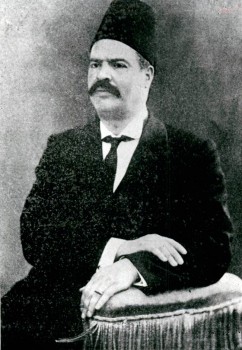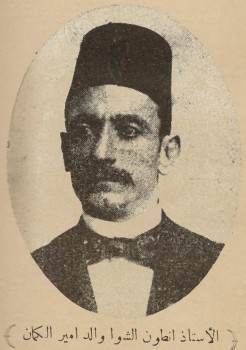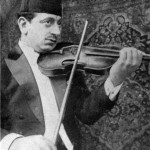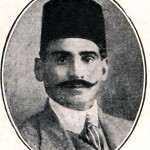The Arab Music Archiving and Research foundation (AMAR), in collaboration with the Sharjah Art Foundation (SAF), presents “Durūb al-Nagham”.
Dear listeners,
Welcome to a new episode of “Durūb al-Nagham”.
Today, we will be talking about the kamān.
In Persian, kamān or kimān means “bow” and kimān tshēh means “with a bow”. Thus, an instrument played with a bow is a kimān tshēh, or kamanja, or kamān.
The kamān implied here is the violin developed in Europe and belonging today to a family of four musical instruments: violin, viola, cello, and double bass.
Our guest today, great Kuwaiti violinist and researcher Ahmad al-Salihi, will tell us about the History of the kamān up until today.
Good morning Mr. Ahmad.
Good morning.
Let us start from the beginning… as much as possible…
I do not believe the popular stories or the written History of the kamanja stating that it entered the Orient in the 19th century, especially after the publication of those books displaying illustrations and images of the violina, or of earlier instruments like the viola da gamba or the viola d’amore …etc, that imply that there was no difference between the Orient and the West, or that the Ottomans had isolated the region…etc.
You are right: there is the kamanja and there are instruments resembling a kamanja that are not necessarily the kamanja we know today. The old kamanja had more strings, it was longer, and its shape was different from today’s kamanja. All these exist and there are musicians who play these instruments resembling today’s kamanja. In Istanbul, they have the layra that is the classical kamanja similar to the rabāb.
We call it arnaba.
Did the arnaba exist in Egypt?
It was widespread in Istanbul where it was played by great instrumentalists and composers.
But its influence was limited in Egypt at the time under Ottoman authority, with the Ottomans controlling the information and knowledge reaching the Arab countries, Egypt in particular… But this story is questionable.
While, on the other hand, books “Waṣf Maṣr” (the Description of Egypt) and “Safīnat al-Mulk” printed in the mid-19th century mention the kamanja and other musical instruments, thus proving their existence then.
Moreover, Sāmī al-Shawwā’s family were violinists, including his grandfather and his great-grandfather during Ibrāhīm Bāshā’s era.
Another questionable information describes Ibrāhīm Sahlūn as the first Egyptian violinist. Yet, his playing was very evolved and carried a profound musical heritage, thus demonstrating that he surely was not the first.
He certainly does not seem to be…
Certainly not… There were techniques he practiced and applied, and that he surely had not deduced or Arabicized / Egyptianized for the Arabic takht in Egypt. There simply wasn’t time enough for a single person to do all this, He had surely learned from a teacher, most probably a violinist, while, quite strangely and rather illogically, some say his teacher was a rabāba player.
I heard in a radio interview that Ḥasan al-Jāhil played the rabāba before switching to the kamanja.
Maybe.
This was surely before Ibrāhīm Sahlūn…
Shall we listen to something by Ibrāhīm Sahlūn?
Ok.
Ok.
(♩)
It is obvious that he was not the first to play this instrument.
True… On the other hand, Ibrāhīm Sahlūn was the first to record.
Yes, in 1903.
His predecessors had not witnessed the recording era and thus did not have the opportunity to record discs.
Even Antoine al-Shawwā, while being older than Ibrāhīm Sahlūn or his contemporary, recorded later simply because recording entered Cairo before the Levant.
True. Levantine recordings include other violinists besides Antoine al-Shawwā. And Kāmil al-Kula‘ī’s book “Al-Mūsīqī al-Sharqī” printed in 1904 mentions a violinist and violin teacher, which confirms that the violin had been there for some time.
Of course… We only wanted to point out that the violin in Arab Music did not first appear in the 19th century.
The instrument being mentioned in written reference works proves that it was there. Yet, we do not know how it was played, or the quality of the playing… Deeper research and data analysis would lead to better results.
In his book “Waṣf Maṣr” (the Description of Egypt) published in 1798, Villoteau assumed and wrote that the violin may have entered Egypt coming from Greece.
On the other hand, there were many Italian and Greek communities in Egypt, so the violin may have reached it coming from its motherland Italy.
…But this is not the point… Let us go back to the technique, the tuning, the bow, and the ‘afq (down up picking) that are all different from the Western style.
In the beginning there were many different Arabic tunings. On the other hand, there is the Classical Western meter: Sol Re La Mi.
Fifths…
There is the Arabic tuning followed by Sāmī al-Shawwā, Ṣāliḥ al-Kuwaytī, Jamīl Bashīr, and ‘Abduh Dāghir.
And Ibrāhīm Sahlūn before them.
And of course Ibrāhīm Sahlūn. It is: Sol Re Sol Do.
I.e. yakāh dūkāh nawā kardān, one fifth and two fourths.
Another tuning known today in Turkey is also a mix of fifths and fourths: Sol Re La Re.
Sāmī al-Shawwā used it a lot: fifth / fifth / fourth.
True.
In such a case, he used the yakāh second scale-step, producing qabā rāst yakāh dūkāh nawā, where the yakāh is a Re, not a Sol.
In the past, some maqām followed a specific tuning. Today, it is mostly: Sol Re Sol Re,
I.e. fifth / fourth / fifth.
Sol Re Sol Re is indeed used the most and has become the common tuning today. There used to be a specific tuning for a specific maqām, such as the ḥijāzkār and the ḥijāzkār kurd.
Sol Do Sol Do, i.e. fourth / fifth / fourth… right?
Yes… Sol Do Sol Do, a tuning that makes it easy to play the maqām and to improvise to the same maqām, knowing that some maqām are hard to play to the second tuning: in the bayyātī for example, it is only possible to produce a beautiful Do with this tuning.
As I mentioned, there are different tuning in Arab Music in general.
They sometimes took the qarār down to the sīkāh when the maqām was the sīkāh.
What do you mean?
While recording sīkāh, they sometimes took the qarār down from the yakāh to the qabā sīkāh.
While accompanying Yūsuf al-Manyalāwī for example, Sāmī al-Shawwā played to the same tuning you mentioned but one scale lower, i.e. Fa Do Sol Do, in order to play the rāst Fa, such as in his great performance of “El-bulbul gānī”.
So, in this respect, the violin is similar to the ‘ūd: they are tuned according to the maqām.
True. Like the qānūn that was formerly played without ‘urab: the qānūnist controlled the dimensions with the tuning, through his personal know-how, imagination, and technique.
To all violin, ‘ūd, or even qānūn players, please let your ear be the judge as to the issue of tuning and manipulation of the maqām, not only as a scale order, but as a work method. Fix your strings according to the tune you wish to play to the maqām. Ignore the books you read and the methods you learned in institutes. Your ear is the best judge as to the beat of the maqām, especially in taqsīm.
Today, most violinists play in large bands that must produce a unified sound, opposite to the concept of improvisation and the individual’s personal creativity. Large bands require “computer instrumentalists”: not a single note can be added to the original score. They work on unifying the notes, the playing, and even the bows, aiming at producing one unified musical sound. So, changing the tuning distinguishes a player from the other band members, placing him outside the band. This problem concerns playing as well as the goals of playing.
…Might is right…
This was concerning the tuning.
Now, would you like to start with the left hand or the right hand, you are free…
Concerning playing and technique, note as a rule that the comprehensive Western methodology including exercises and training is very important to develop either Oriental, Western, or any type of playing.
You mean the bow and fingers’ training exercises, right?
Of course.
This technique is used to serve the desired playing, added to exercises and techniques specific to Arab Music, such as the trill –small or big– types Arab Music is very rich with.
Now let us discuss the quality of the sound produced by the violin.
First, the traditional violin, i.e. with Sāmī al-Shawwā: the sound is weak and limited as the focus is entirely on playing, not the strength of the playing, unlike the very high sounds in Western Music.
Today, the Arab instrumentalist “yuhawwis” as we say in Kuwait, i.e. he applies pressure with the bow in order to produce a higher sound, while in the past, with Sāmī al-Shawwā, Ṣāliḥ al-Kuwaytī, and Jamīl Bashīr, the sound was limited, because the goal was to produce a beautiful sound and gIve a beautiful performance.
They did not apply pressure with the bow because they played on different levels and focused more on producing the sound.
Early instrumentalists focused on producing a specific sound more than a high sound, unlike today’s violinists, regardless of the quality of playing. Most prefer to produce a high sound because things are different today: now large bands similar to Western bands are dominant while in the past, the Arabic takht was dominant. Consequently, the goals are different and each tries to produce a higher sound.
Of course, changing the character of the sounds produced by the Arabic violin is a controversial issue.
A quick note about the bow itself: its ribbon (hank of horsehair) is not fully stretched –at 50%– and the playing is not very strong, in order to produce the specific traditional Arabic sound.
Could you play for us the two sounds produced by the bow, Mr. Ahmad?
Yes.
(♩)
And the second bow…
The strong one…
Stretch the ribbon a little…
(♩)
There are elements in the Arabic technique, like the trills, that do not require strength, but deliberate caution and concentration, and that are missing today in traditional music playing. They only appear in some parts, such as the end of a taqsīma or of a musical phrase, but rarely within the piece, as these can’t be played with the bow pressure practiced today.
All instruments are an object of dispute, not only the violin.
Singing too.
There are many trill types in Arab Music:
First, the ordinary or international trill…
(♩)
This was the obvious or well-defined trill.
Another is a little faster, swifter…
(♩)
There is a trill consisting in a single note, performed for ornamentation purposes, such as…
(♩)
It is used in fast playing: sometimes, the violinist does not have the time to perform a complete trill, and plays one note that sounds like an ordinary trill.
It is a type of ornament.
All are ornaments.
He can use it while playing slowly, not only when he is playing fast.
The very fast small trill is rarely heard, but is present in playing…
(♩) (I am playing it slowly, but it is supposed to be played very fast)
Mr. ‘Abduh Dāghir is famous for this trill type: he preserved it and his whole performance relies on it, i.e. his musical phrases consist exclusively of trills, every note is accompanied by a trill of this type, which of course requires an added effort.
It is similar to the ‘urab: every note is accompanied by a ‘urba, an ornament, a trill of this type.
Are there any techniques specific to right hand playing or left hand playing? We have talked about ornaments played with the left hand. Is there something else?
Concerning the fingers, the zaḥlaqa (gliss) is very important in Arab Music, and different in Turkish music and in Western music. The zaḥlaqa in Arab Music is in between the Turkish and the Western. There are two types of zaḥlaqa or “gliss”:
First, the gliss between two notes…
(♩)
This “sliding” is very distinctive in Classical Arab Music.
The second type consists in the manner in which the note is reached. For example, I could play like this…
(♩)
Or like this…
(♩)
Or for example…
(♩)
This is a faster type of gliss. More precisely described: it is the manner to express the second note. In general, the gliss is obvious between two notes. The second type of gliss is clearly performed on one note… I will illustrate it again with the following example…
(♩)
Also, Arab Music is very rich in vibrato.
Of course, this vibrato bears no relation to the 19th century Bel Canto Vibrato.
Of course not.
Yet most instrumentalists today, even in Arab Music players, play the vibrato performed by the musicians of the Romantic Music Era, which I think is hard on the ear …in Arab Music at least.
As I already mentioned, today’s musicians aim at producing a unified sound, which is achieved at the expense of the nature of Arab Music. They apply the ready-made and clear western methodology and unify the playing in order for the large music band to produce a unified sound, which is done at the expense of the techniques and sounds of traditional Arab Music.
Arabic kamanja playing is rich in vibrato…
(♩)
Concerning the bow played with the right hand, the playing is mostly done with only part of the bow –unlike Western music where the whole length of the bow is used–, except for the long notes that require the use of the whole length of the bow.
Also, the bow’s position on the violin is not close to the tailpiece, but close to the neck or the marāya, i.e. 2-3cm far from the tailpiece. The closer the bow is to the tailpiece, the sharper the sound, while Arab Music requires soft sounds, not sharp ones.
This was about violin techniques.
Let us now talk a little about the major violinists and the most important phases of the violin’s journey in Literary or Classical Arab Music. We naturally do not have any documentation on the subject prior to the recording era, so we only know how it was played from the recordings. No one wrote about the earlier methods in order for us to deduce the way it was played then. All the books on violin were written after the start of the recording era.
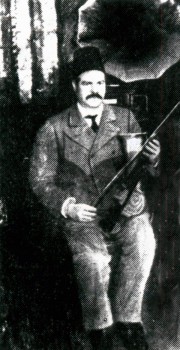 Let us follow the phases of the evolution of violin playing from your point of view.
Let us follow the phases of the evolution of violin playing from your point of view.
The early violinists had started before the recording era. They were major violinists then and recorded these techniques later. They are considered as the representatives of two phases in Arab Music. Among them: Ibrāhīm Sahlūn –who lived in Syria– and Antoine al-Shawwā –who lived in Cairo– were both from the same era.
The playing techniques were limited compared to what happened later: the bow was very limited in its movement and in linking the notes, and the playing was disjointed.
Listen to this phrase…
(♩)
The phrases are simple and the bow is short.
(♩)
This happened very rarely.
We always hear this…
(♩)
This can be noted in Ibrāhīm Sahlūn’s playing, of course more than Antoine al-Shawwā who did not play maqṭū‘āt and whose taqsīm were very short… around ten seconds. He did not play extended taqsīm, not even in songs.
Let us talk about Ibrāhīm Sahlūn: he used many techniques and played very few trills –maybe only one trill type–, while his playing was rich in “gliss” and vibrato. His bow playing was disjointed and he very rarely played the long bow. The structure of his music phrases was also small. His imagination in violin playing was simpler than what happened after him. Thus Ibrāhīm Sahlūn represents the old aspect of Arab Violin.
(♩)
Dear listeners,
We have reached the end of today’s episode of “Durūb al-Nagham”.
We will meet again to resume our discussion about the kamān with Mr. Ahmad al-Salihi.
- 221 – Zakariyya Ahmed – 12 (1/9/2022)
- 220 – Zakariyya Ahmed – 11 (1/9/2022)
- 219 – Zakariyya Ahmed – 10 (11/25/2021)
- 218 – Zakariyya Ahmed – 9 (10/26/2021)
- 217 – Zakariyya Ahmed – 8 (9/24/2021)
- 216 – Zakariyya Ahmed – 7 (9/4/2021)
- 215 – Zakariyya Ahmed – 6 (8/28/2021)
- 214 – Zakariyya Ahmed – 5 (8/6/2021)
- 213 – Zakariyya Ahmed – 4 (6/26/2021)
- 212 – Zakariyya Ahmed – 3 (5/27/2021)
- 211 – Zakariyya Ahmed – 2 (5/1/2021)
- 210 – Zakariyya Ahmed – 1 (4/28/2021)
- 209 – W-al-Lāhi lā astaṭī‘u ṣaddak 2 (4/6/2017)
- 208 – W-al-Lāhi lā astaṭī‘u ṣaddak 1 (3/30/2017)
- 207 – Bashraf qarah baṭāq 7 (3/23/2017)

